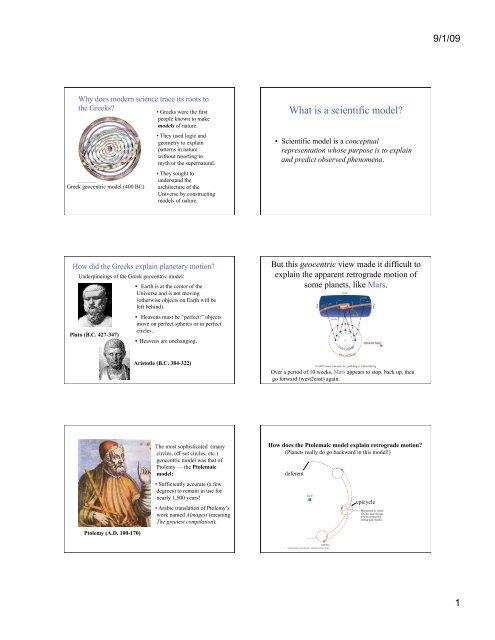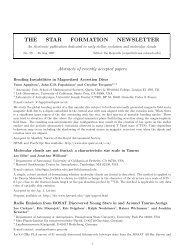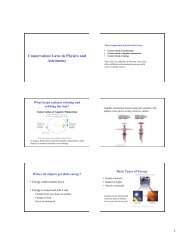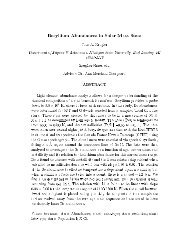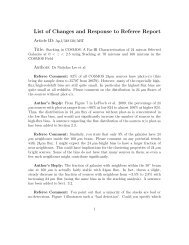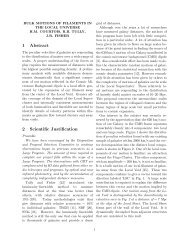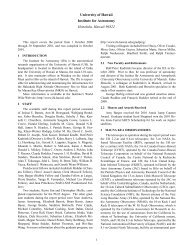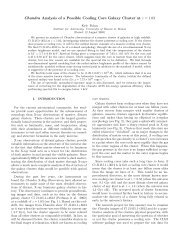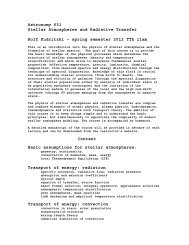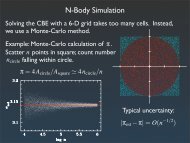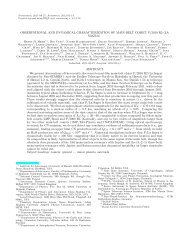2.3MB PDF File
2.3MB PDF File
2.3MB PDF File
Create successful ePaper yourself
Turn your PDF publications into a flip-book with our unique Google optimized e-Paper software.
9/1/09<br />
Why does modern science trace its roots to<br />
the Greeks?<br />
Greek geocentric model (400 BC)<br />
• Greeks were the first<br />
people known to make<br />
models of nature.<br />
• They used logic and<br />
geometry to explain<br />
patterns in nature<br />
without resorting to<br />
myth or the supernatural.<br />
• They sought to<br />
understand the<br />
architecture of the<br />
Universe by constructing<br />
models of nature.<br />
What is a scientific model?<br />
• Scientific model is a conceptual<br />
representation whose purpose is to explain<br />
and predict observed phenomena.<br />
How did the Greeks explain planetary motion?<br />
Underpinnings of the Greek geocentric model: <br />
Plato (B.C. 427-347)<br />
• Earth is at the center of the<br />
Universe and is not moving<br />
(otherwise objects on Earth will be<br />
left behind).<br />
• Heavens must be “perfect:” objects<br />
move on perfect spheres or in perfect<br />
circles.<br />
• Heavens are unchanging.<br />
But this geocentric view made it difficult to<br />
explain the apparent retrograde motion of<br />
some planets, like Mars.<br />
Aristotle (B.C. 384-322)<br />
Over a period of 10 weeks, Mars appears to stop, back up, then<br />
go forward (west2east) again.<br />
Ptolemy (A.D. 100-170)<br />
The most sophisticated (many<br />
circles, off-set circles, etc.)<br />
geocentric model was that of<br />
Ptolemy — the Ptolemaic<br />
model:<br />
• Sufficiently accurate (a few<br />
degrees) to remain in use for<br />
nearly 1,500 years!<br />
• Arabic translation of Ptolemy’s<br />
work named Almagest (meaning<br />
The greatest compilation).<br />
How does the Ptolemaic model explain retrograde motion?<br />
(Planets really do go backward in this model!)<br />
deferent<br />
epicycle<br />
1
9/1/09<br />
How was geocentric model turned<br />
down?<br />
• Earlier models of planetary motion, such as the geocentric<br />
Ptolemaic system and the heliocentric Copernican<br />
system, allowed only perfect circles as orbits.<br />
• These models were therefore compelled to combine many<br />
circular motions to reproduce the variations in the planets'<br />
motions.<br />
• Kepler eliminated the epicycles and deferents that had<br />
made each planet a special case.<br />
• His three laws apply generally to all orbiting bodies.<br />
• Mars was the planet whose motions were in greatest<br />
disagreement with existing models, and its derived orbit<br />
provided the critical test for Kepler’s hypotheses.<br />
• To obtain the precise orbit of Mars, Kepler relied on the<br />
astronomical observations of his mentor, Tycho Brahe,<br />
which were much more accurate than any earlier work!<br />
How did Copernicus, Tycho, Kepler, and<br />
Galileo challenge the Earth-centered idea<br />
to explain the motions of planets?<br />
Nicolas Copernicus (1473-1543)<br />
• He proposed Sun-centered model<br />
presented in Concerning the Revolutions<br />
of the Heavenly Spheres (published in<br />
1543, a few weeks before he died).<br />
• He used the model to determine layout<br />
of the solar system (planetary distances<br />
in AUs and orbital periods)<br />
But: • This model was no more accurate than<br />
Ptolemaic model in predicting planetary<br />
positions, because still used perfect circles.<br />
Tycho Brahe (1546-1601)<br />
• Tycho compiled the most accurate (one<br />
arc-minute!) naked eye measurements<br />
ever made of planetary positions!<br />
• He still could not detect the stellar<br />
parallax, and thus thought that the Earth<br />
must be at the center of solar system<br />
(but recognized that other planets go<br />
around Sun).<br />
• He hired a brilliant mathematician,<br />
Kepler, who used his observations taken<br />
over many years to discover the truth<br />
about planetary motion.<br />
Johannes Kepler<br />
(1571-1630)<br />
• Kepler first tried to match Tycho’s<br />
observations with circular orbits.<br />
• But he found an 8 arc-minute<br />
discrepancy, which eventually led him<br />
conclude that the planetary orbits are<br />
ellipses.<br />
“If I had believed that we could<br />
ignore these eight minutes [of arc], I<br />
would have patched up my<br />
hypothesis accordingly. But, since it<br />
was not permissible to ignore, those<br />
eight minutes pointed the road to a<br />
complete reformation in astronomy.”<br />
What is an Ellipse?<br />
Kepler’s First Law: The orbit of each planet around<br />
the Sun is an ellipse with the Sun at one focus.<br />
An ellipse looks like an elongated circle.<br />
2
9/1/09<br />
Examples of Ellipse Eccentricity<br />
Kepler’s Second Law: As a planet moves around its<br />
orbit, it sweeps out equal areas in equal times.<br />
Planetary orbit eccentricities<br />
Mercury 0.206<br />
Venus 0.0068<br />
Earth 0.0167<br />
Mars 0.0934<br />
Jupiter 0.0485<br />
Saturn 0.0556<br />
Uranus 0.0472<br />
Neptune<br />
0.0086<br />
Pluto 0.25<br />
Kepler was the first to calculate the elliptical orbit of<br />
Mars. This was immensely laborious process, and<br />
Kepler himself referred to this work as “My War with<br />
Mars.”<br />
⇒ This means that a planet travels faster when it is nearer to<br />
the Sun and slower when it is farther from the Sun.<br />
€<br />
Kepler’s Third Law: The square of the period of<br />
any planet is proportional to the cube of the semi<br />
-major axis of its orbit.<br />
T 2<br />
a =2.97 s 2<br />
3 ×10−19<br />
m 3<br />
This law results to the law<br />
of gravitation discovered<br />
by Newton later on!<br />
T 2 = 4 π 2<br />
G M S<br />
a 3<br />
a 3<br />
T 2 <br />
Summary of Kepler's Laws<br />
I. The Law of Ellipses: The shape of each planet's orbit is an<br />
ellipse with the Sun at one focus.<br />
II. The Law of Equal Areas: An imaginary line drawn from the<br />
center of the Sun to the center of the planet will sweep out equal<br />
areas in equal periods of time at all points in the orbit.<br />
III. The Law of Harmonies: The ratio of the cube of the semimajor<br />
axis a to the square of the orbital period T is the same for<br />
all the planets including the Earth, i.e., a 3 /T 2 =constant.<br />
• Kepler's first and second laws were published in 1609 in<br />
Commentaries on the Motions of Mars.<br />
• The third law appeared in 1619 in Harmony of the Worlds.<br />
€<br />
Galileo (1564-1642)<br />
How did Galileo solidify the<br />
heliocentric model?<br />
He overcame the major objections<br />
to the Copernican view. Three key<br />
objections rooted in Aristotelian<br />
view were:<br />
1. Earth could not be moving because<br />
objects in air would be left behind.<br />
2. Non-circular orbits are not “perfect”<br />
as heavens should be (well, heavens<br />
are not perfect, look at the Moon!).<br />
3. If Earth were really orbiting Sun,<br />
we would detect stellar parallax<br />
(well, not if stars are far, far away!).<br />
Overcoming the first objection: nature of motion<br />
Galileo’s experiments showed that objects in air would<br />
stay with a moving Earth.<br />
• Aristotle thought that all objects naturally come to rest.<br />
• Galileo showed that objects will stay in motion unless<br />
a force acts to slow them down (Newton’s first law of<br />
motion).<br />
3
9/1/09<br />
Overcoming the second objection: heavenly perfection<br />
Overcoming the third objection: stellar parallax<br />
• Tycho’s observations of a comet and<br />
supernova already challenged this idea.<br />
• Using his telescope, Galileo saw:<br />
sunspots on Sun (“imperfections”)<br />
mountains and valleys on the<br />
Moon (proving it is not a perfect<br />
sphere!)<br />
• Tycho thought he had measured stellar distances, so<br />
lack of parallax seemed to rule out an orbiting Earth.<br />
• Galileo showed stars must be much farther than<br />
Tycho thought — in part by using his telescope to see<br />
the Milky Way is countless individual stars.<br />
If stars were much farther away, then the lack of<br />
detectable stellar parallax was no longer so troubling!<br />
• The Catholic Church<br />
ordered Galileo to recant his<br />
claim that Earth orbits the<br />
Sun in 1633.<br />
• His book on the subject was<br />
removed from the Church’s<br />
index of banned books in<br />
1824.<br />
• Galileo was formally<br />
vindicated by the Church in<br />
1992 (359 years later!).<br />
Summary<br />
• How did Copernicus, Tycho and Kepler challenge the<br />
Earth-centered idea?<br />
• Copernicus created a Sun-centered model; Tycho<br />
provided the data needed to improve this model; Kepler<br />
found a scientific model that fit Tycho’s data!<br />
• What was Galileo’s role in the Copernican revolution?<br />
• His experiments and observations overcame the remaining<br />
objections to the Sun-centered solar system!<br />
Kepler's Foretelling of the<br />
Law of Gravity<br />
• Kepler believed that the Sun did not sit passively at the center of the<br />
solar system, but that through some mysterious power or “virtue”<br />
actually compelled the planets to hold to their orbits.<br />
• Because the planets moved slower when they were farther from the<br />
Sun, this power must diminish with increasing distance.<br />
• The idea that the planets were controlled by the Sun was developed by<br />
Isaac Newton in his laws of motion and law of gravitation.<br />
• Newton assumed that the Sun continuously exerts a force on each<br />
planet that pulls the planet toward the Sun.<br />
• He calculated that elliptical orbits would result if the force varied<br />
inversely as the square of the distance from the Sun (i.e., when the<br />
distance doubles, the force becomes four times weaker).<br />
Hallmarks of Science: #1<br />
Modern science seeks explanations for<br />
observed phenomena that rely solely on<br />
natural causes.<br />
4
9/1/09<br />
Hallmarks of Science: #2<br />
Science progresses through the<br />
creation and testing of models of nature<br />
that explain the observations as simply<br />
as possible.<br />
Hallmarks of Science: #3<br />
A scientific model must make testable<br />
predictions about natural phenomena<br />
that would force us to revise or abandon<br />
the model if the predictions do not<br />
agree with observations.<br />
What is a scientific theory?<br />
• The word theory has a different meaning in science<br />
than in everyday life.<br />
• In science, a theory is NOT the same as a<br />
hypothesis, rather:<br />
• A scientific theory must:<br />
Explain a wide variety of observations with a few simple<br />
principles, AND<br />
Must be supported by a large, compelling body of evidence.<br />
Must NOT have failed any crucial test of its validity.<br />
Born: 19 February 1473<br />
Birthplace: Torun, Poland<br />
Death: 24 May 1543<br />
Best Known As: Astronomer known for figuring out<br />
that the Sun is the center of our solar system.<br />
For years he worked on his theory that the planets<br />
in our solar system revolved around the Sun<br />
(Ptolemy of ancient Greece had explained that the<br />
universe was a closed system revolving around the<br />
Earth, and the Catholic church concurred). Hesitant<br />
to publish his work for fear of being charged with<br />
heresy, Copernicus summarized it in 1530 and<br />
circulated it among Europe's scholars, where it was<br />
greeted with enthusiasm. His work, titled De<br />
Revolutionibus Orbium Coelestium was finally<br />
published in 1543, apparently just a few weeks<br />
before he died!<br />
Because Copernicus' heliocentric theory of the<br />
planets defied 1,500 years of tradition, some<br />
Nicolas Copernicus<br />
(Astronomer/Mathematician)<br />
historians mark the publication date of De<br />
Revolutionibus as the beginning of the “scientific<br />
revolution.” It was not until 1835 that his work was<br />
taken off the list of books banned by the Vatican…<br />
Other scientists who got in trouble for believing that<br />
the Earth moved around the Sun were Johannes<br />
Kepler and Galileo Galilei.<br />
Tycho Brahe<br />
(Astronomer)<br />
Johannes Kepler<br />
(Mathematician/Astronomer)<br />
Born: 14 December 1546<br />
Birthplace: Skane, Denmark (now Sweden)<br />
Death: 24 October 1601 (gastrointestinal trouble)<br />
Best Known As: Denmark's hottest stargazer<br />
Brahe is not as famous as Galileo or Copernicus, but<br />
in some circles he is considered the father of<br />
modern astronomy. He spent much of his life<br />
compiling the world's first truly accurate and<br />
complete set of astronomical tables — all before the<br />
invention of the telescope! Brahe's assistant,<br />
Johannes Kepler, later used the tables to deduce<br />
the laws of planetary motion.<br />
In 1566 Brahe lost most of his nose in a duel, and<br />
wore a metal replacement the rest of his life.<br />
Born: 27 December 1571<br />
Birthplace: Weil der Stadt, Württemberg<br />
Death: 15 November 1630<br />
Best Known As: The astronomer who explained planetary<br />
motion<br />
Johannes Kepler supported the heliocentric theory by Nicolas<br />
Copernicus, defending it in his first major work, Mysterium<br />
Cosmographicum (1596). In 1601 Kepler became the imperial<br />
mathematician to Rudolf II (emperor of the Holy Roman<br />
Empire), succeeding Tycho Brahe. Using Brahe's data, between<br />
1609 and 1619 Kepler developed his three laws of planetary<br />
motion in Astronomia Nova and Harmonices Mundi. In 1628<br />
Kepler published the Rudolphine Tables, a list of remarkably<br />
accurate logarithmic astronomical tables based on Brahe's<br />
observations and Kepler's subsequent analysis. Thanks in part<br />
to a telescope he received from Galileo (they knew each other<br />
through correspondence only), Kepler also advanced the<br />
science of optics. His achievements in astronomy and<br />
mathematics shaped our current understanding of the solar<br />
system.<br />
5
9/1/09<br />
Galileo Galilei<br />
(Astronomer/Mathematician)<br />
Born: 15 February 1564<br />
Birthplace: Pisa, Italy<br />
Death: 8 January 1642<br />
Best Known As: One of the greats of modern<br />
science<br />
Galileo's achievements include: demonstrating that<br />
the velocities of falling bodies are not proportional<br />
to their weights; showing that the path of a<br />
projectile is a parabola; building the first<br />
astronomical telescope; coming up with the ideas<br />
behind Newton's laws of motion; and confirming the<br />
Copernican theory of the solar system. He was<br />
denounced for heretical views by the church in<br />
Rome, tried by the Inquisition, and forced to<br />
renounce his belief that the planets revolved around<br />
the Sun.<br />
The Vatican officially recognized the validity of<br />
Galileo's work in 1993 — 351 years after his death!<br />
6


